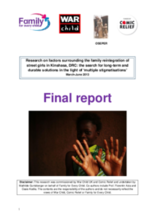This research looked at the factors affecting the family reintegration of girls in the Tshangu district of Kinshasa, an operational zone of the local NGO OSEPER, a partner of War Child for a 3-year project, seeking to address the needs of street-connected girls, including family reintegration. The interviews included a sample of 32 girls living and working on the streets, among whom 24 had already tried family reintegration but had since returned to the streets. It also included 26 families/caregivers, including 10 cases in which girls had returned to the streets after having been reunified. This research aimed at uncovering the complex dynamics behind the issue of family reintegration of girls in Kinshasa, what makes girls want to stay in their family environment and what are the interventions that are likely to support their durable reintegration, either in their original family or another family, or through other ways that will be safer for them than the mechanisms they currently resort to for their survival. There are an estimated 20,341 children with street connections in Kinshasa, 44% of which are girls (REJEER, 2010). NGOs estimate that 9 girls out of 10 are living from income from prostitution and that the average age for starting sexual activity on the streets is 12 years old.
Of the girls interviewed, 40% stated that conflict, abuse and neglect in the family forced them on to the streets; while 38% left following accusations of witchcraft, which also involves high levels of violence and sometimes torture as part of expiation or purification rites. It appears that these 2 factors are major push factors leading girls to the streets. Family breakdown was found to be a recurrent characteristic among most of the families. Among street- connected girls, 62% were not living with one or both their biological parents at the time of departure to the streets (but with a grandparent, uncle, aunt, sister etc). Furthermore, girls, who as a result of family separation are now being cared for by a new step-father or step-mother, often have to face more complex relationships which can be conflictual or abusive.
Nearly all the girls in the participatory exercises mentioned that they could see “no advantage at all” to life on the streets, although some mentioned autonomy (human and financial) as a key advantage. Testimonies from girls participating in the research and respondents to interviews revealed that a common pattern of routine violence and sexual exploitation from older peers, such as Street friends, “protectors”, boyfriends and “sister yayas” (big sisters), including cruel street initiation rites involving being forced to have sex with older men or being subjected to gang rape by groups of street boys, is the issue that concerns them most while on the streets.
The research found that across all categories interviewed one of the key reasons why reintegration fails is that the initial cause for departure and/or family separation has not been properly addressed before reintegration, and therefore girls return to an environment in which they still feel uncomfortable, unsafe, or discriminated against. Factors identified through the research as contributing to making reintegration more difficult included the length of time on the streets and strength of connection to the streets, the nature of the girl’s work on the streets (stigmatization linked to prostitution), the differential benefits and services received in day/residential centres (in comparison with family), as well as “felt” or real donor and management pressure to achieve reintegration targets resulting in rushed reintegration. Factors influencing successful family reintegration included affection and acceptance in the family where girls are reintegrated, and the family readiness and appropriate care arrangements.
The research also explored the range of care options and found that the vast majority of the girls interviewed (78%) affirmed their wish to return eventually, even among those that had experiences of failed reintegration, although not necessarily with the same family member with whom they were living before. This, according to the authors, shows that there is usually someone, within the larger biological family, with whom the girl has kept good relations and with whom she can see herself living. It reviews the use of short term and longer-term residential care but highlighted that only a tiny minority of girls interviewed mentioned residential centres as a favorite place to be or live.
A range of other care options is reviewed including the use of foster families, group homes and independent living. These options were generally not seen as culturally acceptable, although a small foster care scheme is being piloted in Kinshasa. The authors conclude that there is no one single care option or model that will suit girls connected to the streets, therefore a wider range of alternative care options need to be tested to meet girls’ needs. It calls on the agencies to consider piloting fostering and kinship care, offering also short-term alternatives to a centre based approach such as temporary kinship care for girls who have kept positive links with a particular relative or family friend.
©Family for Every Child, War Child, OSEPER, Comic Relief

